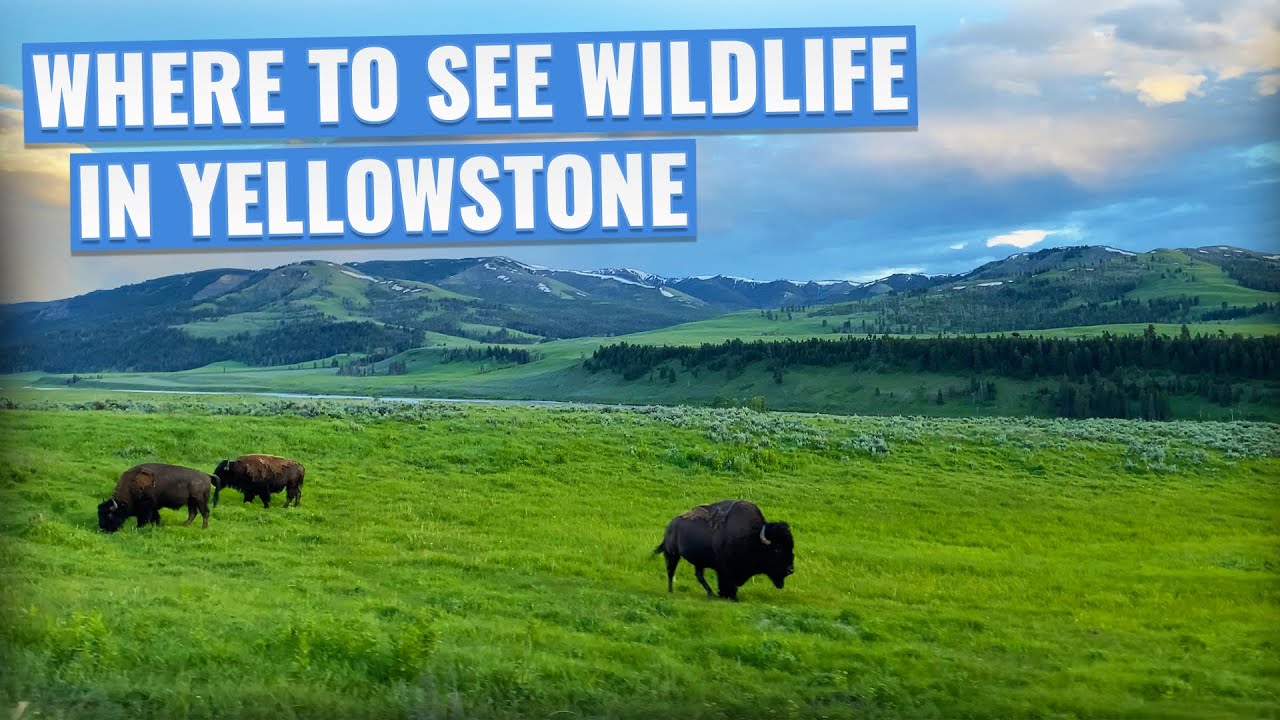Title: Unveiling Nature’s Wonders: Discover the 7 Best Places to See Wildlife in Yellowstone National Park
Introduction: Welcome to the wild side of Yellowstone National Park, where nature unfolds its vibrant tapestry in the form of diverse wildlife. If you’re an avid nature enthusiast seeking an unforgettable wildlife experience, you’re in for a treat. Yellowstone, with its expansive landscapes and unique ecosystems, offers a front-row seat to observe some of the most fascinating creatures on the planet. In this guide, we’ll take you on a journey through the 7 best places to see wildlife in Yellowstone National Park.
1. Lamar Valley: A Haven for Wolves and Bison
Witness the Drama of the Wolf Packs Yellowstone’s Lamar Valley is often referred to as the “Serengeti of North America” due to its abundant wildlife. Venture into this expansive valley at dawn or dusk, and you might be lucky enough to witness the mesmerizing spectacle of wolf packs on the hunt. The Lamar Valley is also a prime location for spotting the iconic Yellowstone bison, as they graze peacefully against the backdrop of the majestic Absaroka Mountains.
2. Hayden Valley: A Wildlife Photographer’s Paradise
Capture the Grace of Elk and Grizzlies For those with a keen eye for photography, Hayden Valley is a dream come true. This vast expanse of meadows is home to the park’s largest elk population. In addition to the elk, keep your camera ready for the awe-inspiring sight of grizzly bears meandering through the valley. Remember to maintain a safe distance and appreciate these magnificent creatures from the heart of their natural habitat.
3. Grand Canyon of the Yellowstone: Home to Majestic Birds of Prey
Marvel at the Soaring Eagles and Ospreys The Grand Canyon of the Yellowstone isn’t just a geological wonder; it’s also a haven for avian enthusiasts. As you gaze into the canyon’s depths, look up to the skies, where eagles and ospreys gracefully soar. Their nests perched high on the canyon walls provide a unique opportunity to witness the circle of life unfold, with these majestic birds hunting and caring for their young.
4. Mammoth Hot Springs: Where Elk Roam Freely
Share the Boardwalks with Roosevelt’s Elk Mammoth Hot Springs, known for its terraces of travertine, is also a popular gathering place for elk. As you stroll along the boardwalks, you may find yourself in the company of these graceful creatures. During the fall rutting season, the bugling calls of bull elk reverberate through the air, creating an unforgettable symphony of nature. Take your time to observe these magnificent animals and the unique geological formations that surround them.
5. Tower Fall: A Scenic Backdrop for Bighorn Sheep
Spot the Surefooted Bighorn Sheep The picturesque Tower Fall area isn’t just a feast for the eyes with its cascading waterfall; it’s also a habitat for the surefooted bighorn sheep. These agile climbers navigate the rocky terrain with ease, providing a thrilling spectacle for onlookers. Grab your binoculars and enjoy watching these magnificent creatures as they traverse the rugged landscape surrounding Tower Fall.
6. Blacktail Plateau: Discover the Elegance of Pronghorn Antelope
Admire the Graceful Pronghorn Antelope Blacktail Plateau is a less-explored gem that offers a chance to witness the elegant pronghorn antelope in their natural environment. Known for their incredible speed and agility, these animals roam freely on the plateau’s grasslands. Take a moment to appreciate their grace and beauty as they gracefully navigate the open spaces, adding a unique charm to the Yellowstone wildlife experience.
7. West Thumb Geyser Basin: Where Otters Play Along the Shoreline
Delight in the Playful Otters of Yellowstone Lake While exploring the geothermal wonders of West Thumb Geyser Basin, keep an eye out for the playful river otters along the shoreline of Yellowstone Lake. These sociable creatures are often seen frolicking in the water or lounging on the rocks. Witnessing their antics against the backdrop of the geyser basin’s colorful pools adds a delightful touch to your Yellowstone adventure.
Conclusion: Yellowstone National Park isn’t just a geothermal wonderland; it’s a treasure trove of diverse wildlife waiting to be discovered. From the majestic elk in Mammoth Hot Springs to the agile pronghorn antelope on Blacktail Plateau, each corner of the park holds a unique surprise for nature enthusiasts. So, pack your binoculars, lace up your hiking boots, and embark on a wildlife adventure like no other.
FAQs
Q1: Are there guided wildlife tours in Yellowstone National Park? Yes, Yellowstone offers a variety of guided wildlife tours led by experienced naturalists. These tours provide in-depth knowledge about the park’s wildlife and ensure a safe and informative experience.
Q2: What is the best time to visit Yellowstone for wildlife viewing? The best time for wildlife viewing is during the spring and fall seasons when animals are more active. Dawn and dusk also offer optimal viewing opportunities.
Q3: Are there any safety precautions to take while observing wildlife in Yellowstone? Absolutely. It’s crucial to maintain a safe distance from wildlife and never approach them. Always follow park guidelines, stay on designated trails, and use binoculars or telephoto lenses for a closer view.
Q4: Can I see bears in Yellowstone, and how should I react if I encounter one? Yes, bears inhabit Yellowstone. If you encounter a bear, remain calm, speak calmly, and back away slowly. Never run, and carry bear spray as a precaution.
Q5: Are there any rare or endangered species in Yellowstone National Park? Yellowstone is home to the threatened lynx and grizzly bear, emphasizing the park’s commitment to wildlife conservation. Respect their habitat to contribute to their preservation.



